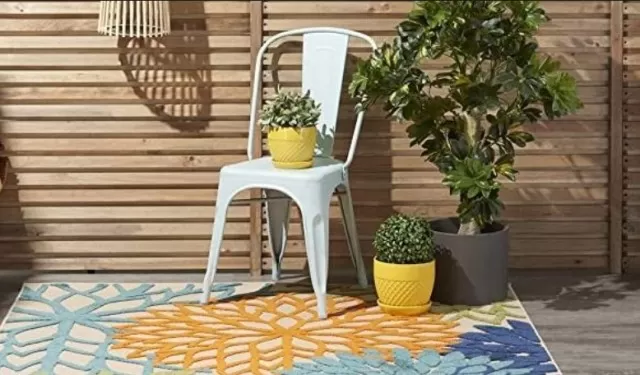Outdoor rugs are a convenient and cost-effective way to enhance the aesthetics of your outdoor living space.
However, if not properly maintained, these rugs can become dirty and accumulate grime over time.
While hosting outdoor gatherings such as playdates, garden parties, or barbecues, it’s common for people to remember to clean tables and chairs but often overlook the outdoor rug.
Outdoor rugs, carpets, and mats are prone to collecting dirt, insects, and allergens that can easily be tracked into the house. Fortunately, most outdoor rugs are designed to withstand various weather conditions, allowing them to maintain their appearance even when neglected.
However, there comes a point when stains, footprints, and debris from surrounding trees become stubborn and require a thorough cleaning.
Pay attention to signs such as noticeable stains, persistent footprints, or debris that doesn’t seem to go away.
These are indications that your outdoor mats and carpets are due for a deep clean. Taking the time to properly clean and maintain your outdoor rugs will ensure they continue to enhance your outdoor space while keeping it clean and inviting for both you and your guests.
What kills mold on an outdoor rug?

To effectively eliminate mold on an outdoor rug without causing harm to surrounding plants, you can use a natural cleaning solution consisting of baking soda and vinegar.
Follow these steps to safely treat your rug:
Start with a dry outdoor rug.
Evenly sprinkle baking soda over the entire rug surface, ensuring thorough coverage. Prepare a mixture of vinegar and water in a spray bottle.
Spray the mixture onto the rug, focusing on the areas affected by mold. Allow the baking soda and vinegar mixture to sit on the rug for several minutes.
This will help break down the mold and inhibit its growth. After letting it sit, use a soft-bristle brush or sponge to gently scrub the rug, paying extra attention to the moldy areas.
Rinse the rug thoroughly with water, ensuring all cleaning residue is removed. Leave the rug to air dry completely before placing it back in its designated outdoor space.
By using the combination of baking soda and vinegar, you can effectively remove mold, mildew, and moss from your outdoor rug while minimizing any negative impact on surrounding vegetation. Remember to wear protective gloves and ensure proper ventilation when handling Cleaning Solutions.
Regular cleaning and maintenance will help prevent mold growth and keep your outdoor rug looking fresh and clean.
Guide to Clean an Outdoor Rug

If you can’t recall the last time you gave your outdoor rug a good cleaning, it’s time to take action.
Follow these six basic steps to get started and restore the freshness of your outdoor space.
Remove the Dirt: Put on a dust mask and gloves before giving your mat or rug a thorough shake.
If it’s small enough, hold it over grass or an open area where the dust can settle. Shake it multiple times to release the dirt.
For larger rugs, drape them over a fence or railing outside and use your hand or a brush to knock loose any surface debris.
Vacuum the Rug: Even after shaking, a fine layer of dust may remain.
Use a vacuum cleaner to clean both sides of the rug. Opt for a vacuum with strong suction power to tackle deep stains and embedded dirt.
Consider using a wet/dry vacuum if your rug’s material allows for it, especially for a more thorough cleaning. Use turbo brushes and handheld rods for pet hair or stains.
Rinse the Rug: If your rug is washable according to the care label, it’s time for a rinse.
Plastic rugs can be hosed down easily. Perform this task on an inclined surface like the driveway or yard to ensure quick water drainage.

Lather and Gently Scrub: Check the care instructions to ensure the cleaning solution won’t damage the rug’s materials.
Create a cleaning solution using diluted dish soap, white vinegar, or baking soda. A few drops of liquid dish soap mixed with warm water usually work well.
For mildew or mold, vinegar or baking soda can be effective, but be cautious not to use too much and affect the rug’s color. Club soda is useful for acidic stains, while a paste of hydrogen peroxide and baking soda can tackle tough spots or greasy messes.
Alternatively, you can choose a specialty or store-bought rug cleaner, such as pet-safe or eco-friendly options. Lather the solution onto the rug and use a soft-bristle brush to gently scrub the spots or the entire surface, as needed.
Rinse and Dry: Thoroughly rinse the rug with water to remove all cleaning agents.
Lay it flat to dry or hang it on a clothesline. Avoid draping it over railings to prevent shape distortion or color transfer.
Flip the rug over to ensure both sides are completely dry. If the material is colorfast, consider sun drying.
Only move the rug to storage or place it back on your patio when both sides are fully dry.
Store or Place the Rug: If you prefer to change your outdoor rug with the seasons, bring it indoors during heavy rain or snowy periods to extend its lifespan.
Roll the rug and secure it with stretch cords or ropes. If storing it outside in a deck or shed, protect it by placing it in plastic or under a tarp.
For smaller rugs that can be stored indoors, choose a convenient location that you’ll remember for easy retrieval next season. Before placing the rug back in its designated spot, ensure the surface where it was previously located is clean.
Pressure-wash the deck or hose down the lawn to create a fresh foundation for your clean rug. Lastly, set a reminder to repeat this cleaning process in approximately three months, once the summer entertaining season concludes.
By following these steps and maintaining a regular cleaning routine, your outdoor rug will stay in great condition and enhance the overall appearance of your outdoor space.
*The information is for reference only.